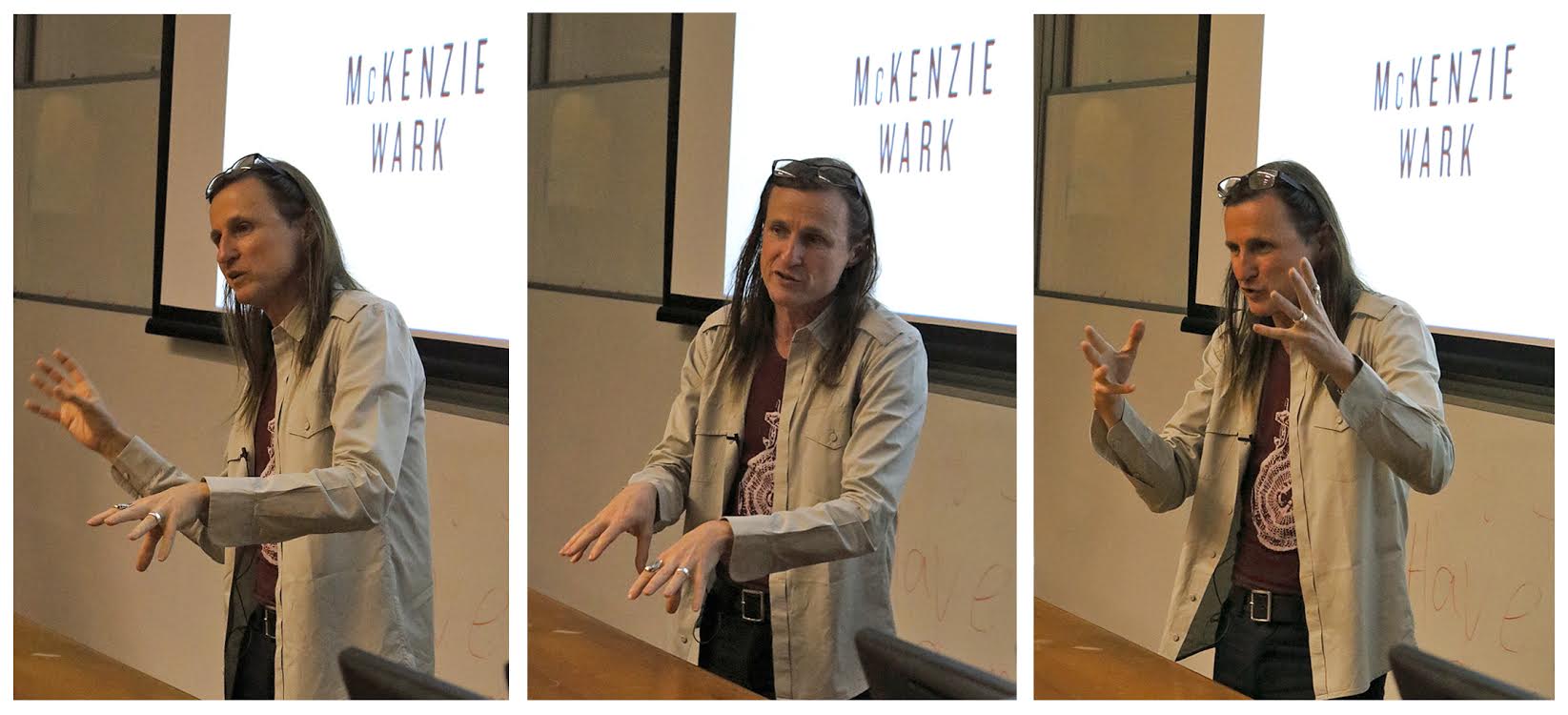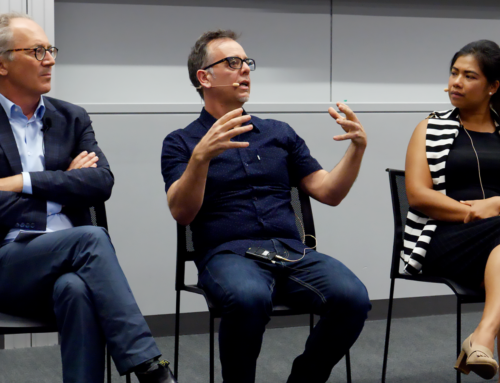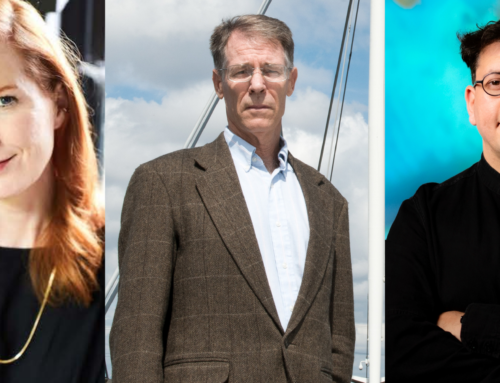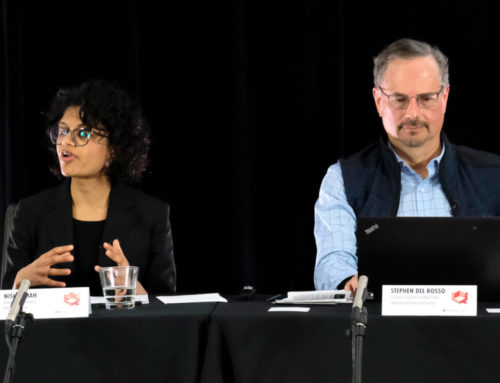If one were asked to choose one word to describe this year’s Q Symposium- an event that defies easy categorization regardless of word count- they could do a lot worse than “big”.
The quantum revolution of the early 20th century came from big changes to the way people thought about the small, which in turn led to new ways of thinking about matters as big as the universe. Now, on a big anniversary of a big war, “Q2: The Space-Time of War and Diplomacy” interrogates the relationship between the development of quantum mechanics and other innovations brought about by the First World War and these big effects. Big concentrations of capital deepened nascent networks of big science, which in turn produced increasing amounts of data novel in both quantity and kind.
This coincided with a pervasive push towards new means of representation across all types of fields. The artistic avant-garde was developing new methods of abstraction just as physicists began using the abstraction of probabilistic mathematics and wave functions to allow for representation of aspects of the universe unable to be observed or even definitively described.
Politics also confronted new issues of representation, with the war and its aftermath bringing new notions of nation, class, and gender to the fore as political identities. In the post-war system of states, bureaucrats and statesmen (at that point still an entirely male labor force) developed practices of permanent representation to embody the state in newly formed international organizations and the practice of issuing passports to represent the state’s subjects.
As per tradition, the Q Symposium opened in the University of Sydney’s famous quad with a public lecture. With this year’s iteration a co-presentation of University of Sydney’s Centre for International Security Studies (CISS) and Sydney Ideas public lecture series, the lecture drew a diverse audience of artists, students, researchers, and intellectuals from across Sydney supplemented by the Q Symposium attendees coming from around the continent and beyond.
Somewhat of a keynote (or Q-note), the lecture ideally sets a tone for the rest of the conference. Given the complexity and expansiveness of the conference’s topics, this is no easy task. But just as last year’s lecture by Lene Hansen on images in security spoke to themes that would recur throughout the conference, McKenzie Wark’s lecture “Exit to the Planetarium” was the perfect spark for getting a diverse audience thinking about the potential entanglements of big science, big data, representation, and new forms of politics through his discussion of climate science and the Anthropocene, drawn from the forthcoming Molecular Red: Theory for the Anthropocene (Verso, 2015).
Before the lecture could begin some acknowledgements were in order. First taking to the stage was Duncan Ivison, Dean of the Faculty of Arts and Social Science at the University of Sydney, who prefaced his remarks by first acknowledging the Gadigal clan on whose traditional land the lecture was taking place. While taking note of USydney as the oldest university on the continent, he emphasized that the site has been a place of learning for over 40,000 years.
He then welcomed the audience and McKenzie back to his native Sydney before delivering some big news. The Carnegie Corporation of New York would shortly announce a major grant of $400,000 over the next two years for CISS to expand its research on the implications of quantum concepts, computing and communications in international security. Duncan Ivison joked that with this recognition, he hoped that “if it was possible to have the center of a quantum anything, that Sydney would be it.” Highlighting its participation in prestigious international partnerships like the project based at University of Copenhagen to study images in IR, he felt that the Q funding was due recognition for the University and CISS as a site for cutting-edge research in international security.
With that, he turned the floor over to Q’s curator, CISS Director James Der Derian who in turn thanked both Duncan Ivison for his critical support, the Carnegie Corporation for the grant, and Sydney Ideas for lending their brand and organizational skill to the lecture. He then asked the audience to turn their attention to the back of the room, to note some of the great minds of philosophy and the classical sciences observing sternly from their perch in two expansive portraits. Der Derian appreciated the presence of these spectres, and the continued influences of their rigor in the physical and social scientists whose welcome presence at Q might help us “keep it honest”.

A full house on the USydney quad for McKenzie Wark’s lecture “Exit to the Planetarium”. (Photo: Gilbert Bel-Bachir)
Q1, James explained, was a proof of concept, an experiment of an experiment. Whereas Q1 confronted questions of the imminent quantum technology in warfare, Q2 is a prequel, starting at somewhat of a beginning by looking at the coeval emergence of big science, big war, and quantum mechanics in the early 20th century. A search for a lecture able to speak convincingly to all of Q’s audiences and more led to McKenzie, whose diverse writings like The Hacker Manifesto, The Beach Beneath the Street, and The Virtual Republic have addressed technology, displacement, the pathologies of modernity, the Situationist International, and theorizing the mediated event. The scope of Wark’s interrogations, Der Derian told the audience, reminded him of Walter Benjamin’s quote that “In times of terror, when everyone is somewhat of a conspirator, everybody will be in the position of having to play detective.”
McKenzie took the stage and after thanking the audience, the venue, and the Gadigal custodians of the land, began with a few slides of family history. He introduced the audience to his great uncle, Blair Anderson Wark, an ANZAC officer who had been deployed to Suez and then the Western Front, where he became a Victoria Cross-decorated hero before returning to Australia and a long and prosperous career in hospital services. McKenzie’s grandfather suffered a different fate, returning from the war emotionally and physically crippled before abandoning his young family and dying within a few years. The war was a human calamity, leaving millions dead, maimed, raped or otherwise touched by its violence. But it was also a war of logistics and technology; managed by quartermasters, scheduled on timetables, made deadlier through scientific discovery.
“’Human multitudes, gases, electrical forces were hurled into the open country, high-frequency currents coursed through the landscape,’” Wark began, quoting from his lecture’s titular inspiration, Benjamin’s “To the Planetarium”. “‘New constellations rose in the sky, aerial space and ocean depths thundered with propellers, and everywhere sacrificial shafts were dug in Mother Earth. This immense wooing of the cosmos was enacted for the first time on a planetary scale—that is in the spirit of technology.’” For Wark, channeling Benjamin, the war formed a newly expansive relationship between nature and techne into an “artillery blasting open the fissures of myth” with the blessings of capital.
Wark then introduced the audience to another man, Alexander Bogdanov, who had been touched by the war like Wark’s ancestors and Benjamin. One of the intellectual inspirations for Wark’s new book, Bogdanov had been a doctor, futurist, theorist, and, in his spare time, Lenin’s primary rival for leadership of the Bolsheviks before 1909. Across his work, from his sci-fi novelization of a socialist Mars (Red Star, 1908), through to his formulations of tektology (a precursor to modern systems theory and cybernetics) and proletkult (the development of a reimagined radical proletarian culture by the artistic and intellectual avant-garde) Wark sees in Bogdanov a constant thread of synthesis. Contra much of critical theory’s tendency towards treating the economic, political, or social in abstraction and isolation, Bogdanov is an early contributor to a tradition since continued by people like Donna Haraway and Karen Barad dedicated to investigating the effects of how and why science and technology operate in and on the world entangled with these spheres of human collective action.
This synthesis, Wark continued, aimed beyond critique to build a new means of production based on knowledge, and with it a new infrastructure through which the world could be sensed. While Bogdanov would not live to see it, the world has developed into an information society and with it a new infrastructure through which to view nature and the world: the natural-technical apparatus of climate science. Climate science, Wark explained, is science of a particular kind, a science which demands a global synthesis of technology and practice as its object demands a holism in defiance of the classical isolation of the controlled experiment, the vivisection, the et ceterus paribus.
The notion of “A Vast Machine”, the title of Paul Edwards’s book on climate science, came from an 1837 remark by John Ruskin theorizing a panoptical apparatus capable of determining global weather at any given point. Wark uses Edwards as a point of synthesis with Bogdanov, highlighting the similarity of Edwards notion of “data friction” with Bogdanov’s “resistance”, a concept highlighting how the “real”-ness of data prevents its collectors from perfect representation. For Edwards and Wark, “data are things”- products of labor material and practical in itself and understanding the politics of climate science then necessitates studying the means of its production.
Like atomic physics, the development of an infrastructure of climate science is bound up in the scientific labors of warfare. Warfare served as both application and data source as planners sought to forecast and even weaponize weather in their operations while spawning the creation of new data by pushing planes higher in the sky and ships further out to sea. Just as the internet developed from desires for a closed communications network able to survive a nuclear exchange, much of modern climate science developed through a desire to understand and potentially even control weather for military purposes. In addition to using the machine to run calculations for a hydrogen bomb, Johann von Neumann used ENIAC, the world’s first electronic general-purpose computer, to develop a 24-hour weather forecast.
The techno-warfare climate of the Cold War and the concurrent and interrelated developments of computing, nuclear weapons, and a surveillance apparatus of high altitude spy planes and satellites all provided parts of the emergent assemblage of climate science. Tracking the fallout of above-ground testing meant understanding weather patterns, high-risk, high-altitude overflights were meaningless without knowing if the target would be obscured by cloud cover, while the third Cray supercomputer (the first not used for modeling thermonuclear explosions) was dedicated to climate modeling.
But while most use of the techno-security-surveillance complex was a competitive endeavor between the superpowers, Wark explained that climate science became a globalized and largely cooperative pursuit. Former colonies viewed their participation as a means of ascent to the international system, while the US and USSR both began sharing their data with the People’s Republic of China a later participant in the climate data exchange. Beginning in the late 1970s, the Global Weather Experiment became one of the biggest science experiments in history by drawing on simultaneous weather data from over 140 countries and prompting recurrent international workshops for participants.
From this emergent globalized knowledge infrastructure, climate data is a very real global product of truly globalized knowledge production practices. This data, Wark reminds the audience again, has its own materiality—it is its own “thing” in the world. As coalesced around modeling, Wark sees evidence in the co-constitutive relationship of data to model of what Karen Barad calls “intra-action” — the inseparability or entanglement (Barad, trained as a particle physicist, cites Bohr extensively) of agencies and factors — between the data and model. Models are constructed with data from the “real” world, but the models themselves then acquire the capacity to modify qualities of the data itself through the intra-acting agencies of data and model.
For Edwards, climate science is not a reductionist science but a reproductionist one in which models emerge as key mediators between the apparatus, the data, and the theory. There is no “purity” to data or theory, each is intra-acting and thus a large gap appears between data and analysis. As much of the data was collected for weather prediction, a comparatively short-term predictive enterprise, we lack consistent metadata and minute variations in collection, recording, or processing may compound over time.
While the globalized practices of climate production overcame the most obvious lines of parochial resistance or friction- those between otherwise obstinate and mutually suspicious superpowers- it is the friction between data, model, and theory that have provided the openings for denialism in the face of overwhelming scientific consensus. It was efforts to revise and correct historical climate data at East Anglia University in 2009 that prompted the “Climategate” scandal, enabling denialists to misrepresent hacked emails and fling claims of malfeasant data manipulation at climate scientists. Every election cycle, the critique of science shifts a bit further from the romantic left of Benjamin and Adorno to the reactionary right and its financiers with a vested interest in maintaining (or increasing) current levels of consumption and carbon emission.
Wark concluded his lecture with a call-to-arms, a need to recognize where and when the leftist critique of science is appropriate. The militaristic language was ironically appropriate, the lecture demonstrating as it did the consistent entanglement of climate science with the techno-scientific endeavors of warfare. For Wark, this science may have prompted some moves towards international cooperation (cooperation not easily overstated in light of persistent impasses in the UN frameworks for climate negotiations) but it remains entangled with conflict. Of the many sciences and technologies borne of war, climate science persists as a science of conflict—not conflict between states but the conflict between our species of being, our infrastructure, and our environment. The Anthropocene, he finished, is not the result of a psychic or political unconsciousness, it is heavily mediated and widely understood. The Anthropocene is rather the result of an infrastructural unconsciousness. What is needed then is not a new humanity, but the building of a new infrastructure.

McKenzie Wark listens to a question from the audience after delivering his lecture.
(Photo: Gilbert Bel-Bachir)
This would be a doubtlessly big project, and the audience had understandably big questions about it. With the floor opened to questions, many in attendance seemed to keen to answer the call, if still unsure as to how best to do so. The first question came from a young art student, who wanted to know what role, if any, Wark saw for art in this project. Wark’s response echoed notions of Bogdanov’s proletkult, in that he saw a critical place for art in understanding and changing how we relate emotionally or imagine the spaces that data are in. There were all sorts of things, he argued, we could be doing “to affect our affect” and there were plenty of opportunities to contribute new thinking on how we can imagine the future.
Another audience member asked a question of time and temporality, wondering what should be made of a politics that occurs at a glacial pace while the glaciers themselves recede with unprecedented speed. It is, Wark responded, a question of value. Our society has mastered techniques of valuation and trading in fractions of a second, but has proven much more ill-equipped to calculate value over durations of hundreds or thousands of years. Learning or making a means of doing so requires imagining a new civilization, a necessity that could be as exciting as it is generally regarded as inducing despair.

CISS Director James Der Derian moderates as the audience asks questions of McKenzie Wark. (Photo: Gilbert Bel-Bachir)
A follow-up asked, was it not too much to ask of a generation so often criticized, rightly or wrongly, for an addiction to instant gratification to imagine a new civilization capable of the long-term perspective necessary for meaningful climate action? Wark seemed to question the utility of the self-flagellating tone pervasive in climate discourses. “We are not fallen angels,” he announced, “but monkeys with ambitions.” The question we should be asking ourselves is less along the lines of what is wrong with us? and more how do we build systems that interact with our desires through useful intra-action?
How indeed? The following morning, participants from around the continent and the world would take up again discussions started by the lecture, at the reception, or even carried over from Q1. For the Q Symposium- an event that is as much about asking new questions as it is about providing new answers- the lecture provided a perfect start for considering these kinds of big questions.







Very cool. I’m writing an update to McKenzie Wark’s Gamer Theory. Help me get the word out?
Kck.st/1SV9PaO
[…] Thursday’s Q Lecture, Mckenzie Wark focused on the gaps that exist between data, models, and theory. On Friday, Andrea […]
[…] his Q Lecture the night prior, McKenzie Wark discussed Paul Edwards’s description of climate science as a […]
[…] From: Q2 Tagged: #QuantumIR, Carnegie Corporation of New York, Centre for International Security Studies, CISS, Security Studies, Technology, University of Sydney, Warfare, World War 1 Previous post […]